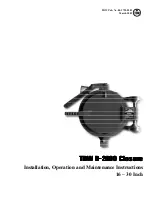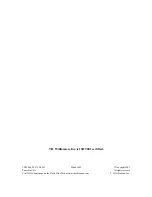
4
B. Standard Barrel Collar—Materials:
•
ASTM A694 F46
•
Carbon maximum: 0.26%
•
Manganese maximum: 1.40%
•
Minimum tensile strength: 60,000 psi
•
Minimum yield strength: 46,000 psi
1. TDW refers the welder to the applicable
codes such as ASME, API, ANSI, etc.
These codes require that the welder and
the weld procedure be previously
qualified.
2. These codes recommend the proper
preheat and post-weld heat treatment
procedures. The welder should refer to
these codes and follow the recommended
welding procedures for the materials being
welded.
NOTE:
Standard barrel collar material and
properties shown above. Other materials
provided on request. Refer to material test
reports supplied with each closure to determine
weld procedure for actual materials being
welded.
NOTE: Any practical welding process (manual,
submerged arc, etc.) can be used. Applying as
low a heat range as possible is recommended,
to help prevent the barrel collar sealing surface
from warping.
C. The procedures for welding are as follows:
1. Position the barrel collar to align properly
with the vessel. Make sure the door hinge
is vertical (horizontal for a vertical
installation).
CAUTION: When welding to a vessel of high-
yield strength steel (over 71,000 psi),
preheating may be required to avoid
cracking. Refer to proper ASME, API, or
ANSI codes.
2. Tack weld approximately every four
inches around circumference and check
again for proper alignment.
CAUTION: When welding on the barrel collar, a
low welding heat range and the following
proper sequence of welds will help
prevent possible warping of the barrel
collar sealing surface.
3. Weld stringer bead and immediately start
the hot pass with two or more men on
opposite sides to equalize stress. Figure 4
shows the recommended welding
sequence.
Figure 4. Recommended Welding Pass Sequence
4. When the welding process is completed,
replace the O-rings on the closure door and
the pressure warning lock.
D. If post-weld heat treatment is required, a
localized heat treatment procedure should be
followed.
1. Coat the O-ring groove with a heat
resistant material (such as "TURCO PRE-
TREAT," or "WATER NO SCALE") for
protection during post-weld heat treatment.
2. Precautions such as interior braces should
be used during treatment so that the barrel
collar does not warp or droop.
3. After post-weld heat treatment, clean the
barrel collar and reinstall the O-ring. Open
and close the door to check for proper
actuation and alignment.
4. If a localized heat treatment procedure is
not possible, the door and clamp ring pivot
nut must be removed prior to heat
treatment. (See Subsection 3.1, beginning
on page 9 for removal instructions.)
CAUTION: When cleaning the barrel collar, be
very careful not to damage the O-ring
sealing surfaces.
E. Before placing the closure in service, all
surfaces should be clean, with the O-ring and
O-ring sealing surfaces covered with a thin






































